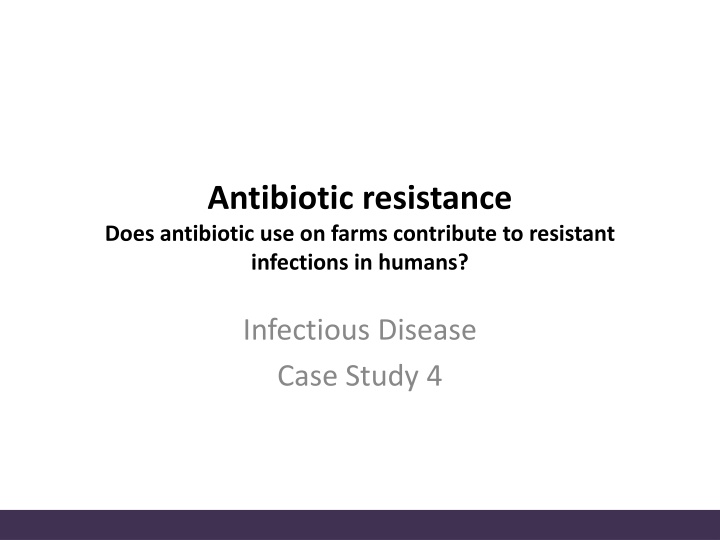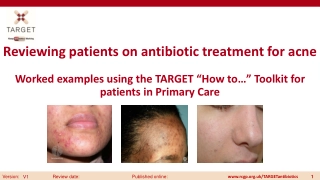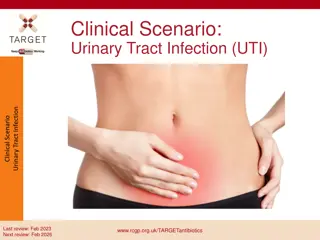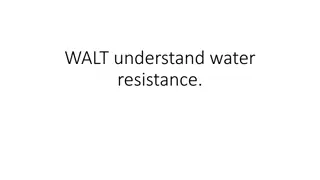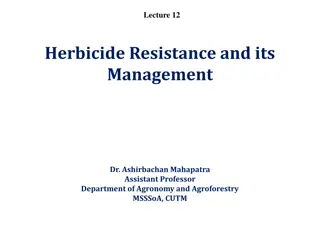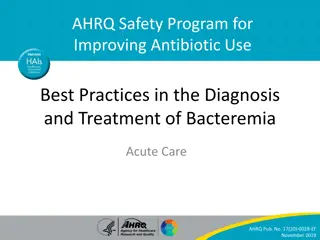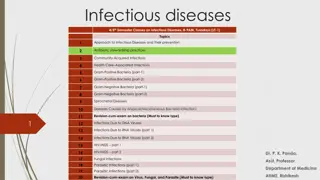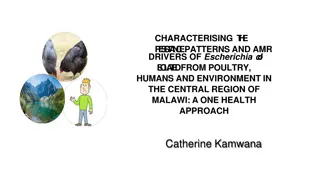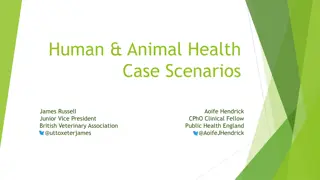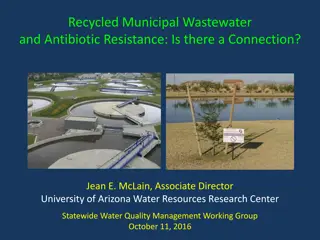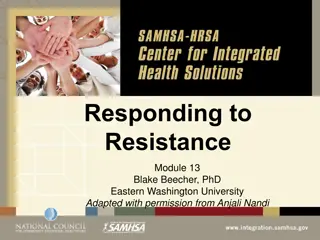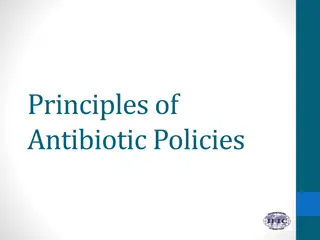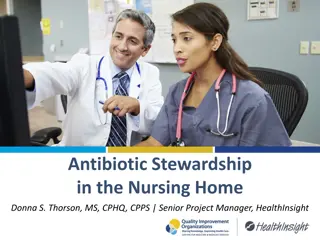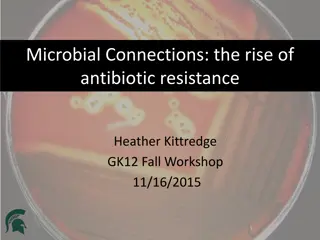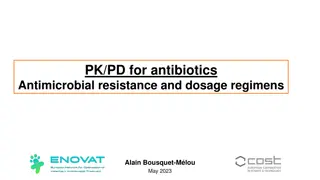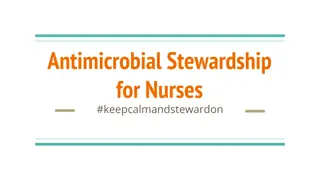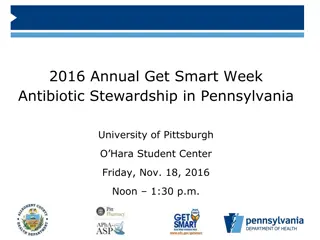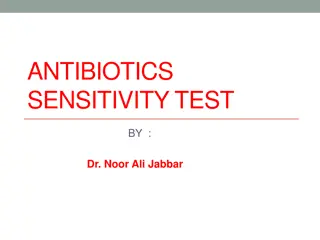Antibiotic Resistance in Humans: Impact of Antibiotic Use on Farms
Antibiotic resistance is a growing concern, with evidence suggesting a link between antibiotic use in farm animals and resistant infections in humans. Explore a case study of a Salmonella outbreak in Denmark, where antibiotic treatment failed, leading to fatalities. Learn about the role of selection pressure in the evolution of antibiotic resistance and how resistant bacteria can spread. Develop a model to understand this complex issue.
Download Presentation

Please find below an Image/Link to download the presentation.
The content on the website is provided AS IS for your information and personal use only. It may not be sold, licensed, or shared on other websites without obtaining consent from the author.If you encounter any issues during the download, it is possible that the publisher has removed the file from their server.
You are allowed to download the files provided on this website for personal or commercial use, subject to the condition that they are used lawfully. All files are the property of their respective owners.
The content on the website is provided AS IS for your information and personal use only. It may not be sold, licensed, or shared on other websites without obtaining consent from the author.
E N D
Presentation Transcript
Antibiotic resistance Does antibiotic use on farms contribute to resistant infections in humans? Infectious Disease Case Study 4
Learning Objectives antibiotic apocolypse Draw a picture to illustrate the effect of antibiotics on a population of bacteria. Distinguish between antibiotic resistance and an antibiotic-resistant infection. Analyze and make predictions using data on antibiotic resistance. Develop a model to explain how human antibiotic resistant infections may be linked to antibiotic use on animal production farms.
Denmark 1998 Outbreak of 25 cases of food poisoning. All were infected with a strain of Salmonella that is treated with cipro antibiotic. The antibiotic wasn t effective. Two patients died. How did the Salmonella strain become resistant to cipro? We will develop a model to answer this question by the end of this case study Source: Molbak et al. (1999) New England Journal of Medicine 341:1420-1425.
Do Now Understanding the Evolution of Antibiotic Resistance What is the role of selection pressure in the acquisition of antibiotic-resistance? Answer the first question on the worksheet then choose the correct scenario on the following slides
1. Bacteria are exposed to antibiotic Scenario #1: Is this correct? 2. Presence of antibiotic puts pressure on the bacteria to become resistant + + + + + + + + + + + + + + + + + + + + + + + + + + + + + R + + + + + + + + + + + + + + + + + + + + + + + + + 3. Resistant bacteria can then pass the resistance trait onto other bacteria antibiotic Bacterial cell + + + + + + + + R + + + + + + + + + + R R + + + + + + + + + + + + + + + R R + + + + + + + + + + + + + + +
1. Bacteria are exposed to antibiotic; a rare cell is resistant Scenario #2: Is this correct? + + + + + + + + 2. The non-resistant cells die in presence of antibiotic + + + + + + + + + + R + + + + + + + + + + + + + 3. Resistant bacteria can then pass the resistance trait onto other bacteria + + + + + + + + + + + + + + + + + + + R + + + + + + + + + + + + + + + + + + + + + + + + + + + + + + + + + + + + + + + + + + + + + + + + + antibiotic Bacterial cell + + + + + + + + + + + + + R + + R + + + + + + + + + + + R R + + + + + + R + + + + + + + + + + + + + + + +
1. Bacteria are exposed to antibiotic; a rare cell is resistant Scenario #2 is correct + + + + + + + + 2. The non-resistant cells die in presence of antibiotic + + + + + + + + + + R + + + + + + + + + + + + + 3. Resistant bacteria can then pass the resistance trait onto other bacteria + + + + + + + + + + + + + + + + + + + R + + + + + + + + + + + + + + + + + + + + + + + + + + + + + + + + + + + + + + + + + + + + + + + + + antibiotic Bacterial cell + + + + + + + + + + + + + R + + R + + + + + + + + + + + R R + Selective pressure occurs when antibiotics are present. The bacteria that possess the resistance trait are selected to live survival of the fittest! + + + + + R + + + + + + + + + + + + + + + +
Acquisition of resistance is a process of evolution. There is usually a selection pressure that drives the outcome. Those organisms with the beneficial trait survive while others do not.
Activity: Developing a model to link antibiotic use on farms with human infections A lot of antibiotics are used on meat- producing farms in the U.S. What do you predict about bacteria isolated from those farms? Pew Charitable Trusts http://www.pewhealth.org/other-resource/record-high-antibiotic-sales-for-meat-and-poultry-production-85899449119
Determine if the data support your prediction Intestinal microbes present in feces of healthy chickens on farms Number of antibiotic- resistant samples Total number of samples tested Percent resistant Farm type Conventional (antibiotics (Ab) used) 10 13 77% Organic (no antibiotics) 0 16 0% Conventional farms supplement daily animal feed with antibiotic. Do these data support your prediction? Aarestrup (1995) Microbial Drug Resistance 1:255-257.
The data show an association between antibiotic use on farms and carriage of resistant bacteria by animals on those farms. (Many different types of studies have shown the same result) What does this mean for human health?
An early sign that there might be reason for concern In a revolutionary study in 1976: Part 1 - Studied a farm in which antibiotics had not been used. - Took stool samples from chickens, farm family members and neighbors. Part 2 - Added tetracycline (antibiotic) to the feed of chickens on the farm. - Over time, measured the percent of bacteria from stool samples that were resistant to tetracycline. - Measured samples from chickens, farm families and neighbors. Source: Levy et al. (1976) New England Journal of Medicine 295:583-588.
Predict the results What percent of stool bacteria are resistant to antibiotic 48 hour and 3 months after adding it to chicken feed? Graph for each group sampled (chickens, farm family and neighbors) chickens farm family neighbors 100? 100? 100? Percent antibiotic 80? 80? 80? farm? farm? farm? 60? 60? resistant 60? neighbor? neighbor? neighbor? 40? 40? 40? Boston? Boston? Boston? 20? 20? 20? 0? 0? 0? 0-20%? >20-80%? >80-100%? 0-20%? >20-80%? >80-100%? 0-20%? >20-80%? >80-100%? Prior to antibiotic 48 hours 6 months Adapted from results in Levy et al. (1976) New England Journal of Medicine 295:583-588.
Predict the results What percent of stool bacteria are resistant to antibiotic 48 hour and 3 months after adding it to chicken feed? Graph for each group sampled (chickens, farm family and neighbors) chickens farm family neighbors 100? 100? 100? Percent antibiotic 80? 80? 80? farm? farm? farm? 60? 60? resistant 60? neighbor? neighbor? neighbor? 40? 40? 40? Boston? Boston? Boston? 20? 20? 20? 0? 0? 0? 0-20%? >20-80%? >80-100%? 0-20%? >20-80%? >80-100%? 0-20%? >20-80%? >80-100%? Prior to antibiotic 48 hours 6 months Adapted from results in Levy et al. (1976) New England Journal of Medicine 295:583-588.
Association was made between antibiotic use on farms and carriage of resistant bacteria by humans who live on those farms. (Many different types of studies have shown the same result)
Does having antibiotic-resistant bacteria on your skin or in your intestinal tract make you sick?
What is the result of having tetracycline- resistant bacteria in/on your body? A. You will be sick and treatment with tetracycline won t cure the infection. B. You will be sick, but treatment with tetracycline should clear the infection. C. You are not necessarily going to get sick. D. You will not get sick because you are resistant to tetracycline infections.
What is the result of having tetracycline- resistant bacteria in/on your body? A. You will be sick and treatment with tetracycline won t cure the infection. B. You will be sick, but treatment with tetracycline should clear the infection. C. You are not necessarily going to get sick. D. You will not get sick because you are resistant to tetracycline infections.
Which is an accurate statement? A) Humans can become resistant to antibiotics. B) Humans can get infected with bacteria that are resistant to antibiotics. C) Both are true. D) Neither is true.
Which is an accurate statement? A) Humans can become resistant to antibiotics. B) Humans can get infected with bacteria that are resistant to antibiotics. C) Both are true. D) Neither is true. - Animals do not become resistant to antibiotics, bacteria do. - Some of the normal flora in or on our bodies can be resistant but we may never know it. - We can become infected with resistant types of bacteria.
What is the link between antibiotic- resistant microbes that were found on the farm and the antibiotic-resistant human food poisoning outbreak?
Patients with the cipro-resistant infections were interviewed. Most had eaten pork, worked at the slaughterhouse, or had been in contact with the infected patients. Pork was traced to a single herd of pigs. Pigs from that herd tested positive for the same strain of Salmonella as in the patients. Source: Molbak et al. (1999) New England Journal of Medicine 341:1420-1425.
Wrap Up Provide a model to explain our original question How did the deadly Salmonella strain become resistant to cipro? 1. 2. an antibiotic was used Selection pressure (from the antibiotic) took place leaving behind resistant forms of Salmonella The resistant bacteria remained on the pork after slaughter and delivery Patients ingested the Salmonella either through handling or consumption of raw pork 3. 4.
Proving causation is difficult This single story is not proof that antibiotic use on farms causes resistant infections in humans. But an accumulating number of reports like this are creating consensus amongst scientists that there is a link. For many areas of science, an accumulation of evidence compels adoption of a particular model. For example: Smoking and lung cancer Human activity and global warming
